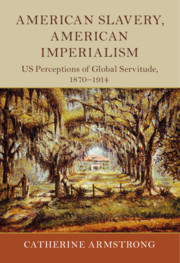Book contents
- American Slavery, American Imperialism
- Slaveries since Emancipation
- American Slavery, American Imperialism
- Copyright page
- Contents
- Figures
- Acknowledgements
- Introduction
- 1 A Rhetorical Continuum? How Representations of Antebellum Slavery Endure in Post-War Culture
- 2 Global Contexts: How External Factors Drive US Perceptions of Slavery
- 3 Othering the Slave Owner
- 4 Othering the Enslaved
- 5 Gender and the Rhetoric of Slavery
- 6 Resistance and the Slavery Counter-Narrative
- Conclusion
- Bibliography
- Index
4 - Othering the Enslaved
Published online by Cambridge University Press: 17 August 2020
- American Slavery, American Imperialism
- Slaveries since Emancipation
- American Slavery, American Imperialism
- Copyright page
- Contents
- Figures
- Acknowledgements
- Introduction
- 1 A Rhetorical Continuum? How Representations of Antebellum Slavery Endure in Post-War Culture
- 2 Global Contexts: How External Factors Drive US Perceptions of Slavery
- 3 Othering the Slave Owner
- 4 Othering the Enslaved
- 5 Gender and the Rhetoric of Slavery
- 6 Resistance and the Slavery Counter-Narrative
- Conclusion
- Bibliography
- Index
Summary
This chapter shows how nascent racially motivated imperialism led to the othering of the enslaved, both within the US as a tool of social control of labour, to justify immigration restrictions on so-called ‘coolies’, and also in order to position the nation alongside European powers in the colonial struggles for parts of the Middle East and Africa. The edges of the definition of slavery was fought over by those arguing that forced labour was the only valid way of eliciting productive labour from uncivilized natives.
- Type
- Chapter
- Information
- American Slavery, American ImperialismUS Perceptions of Global Servitude, 1870–1914, pp. 147 - 184Publisher: Cambridge University PressPrint publication year: 2020

